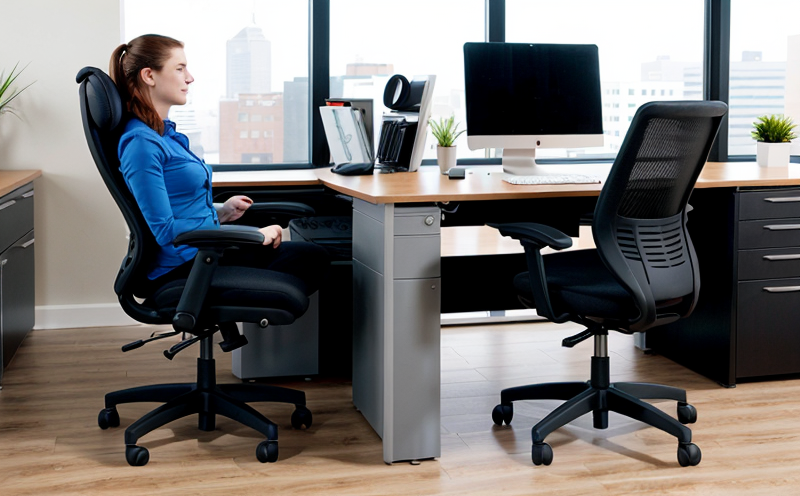BS EN 1335-1 Office Work Chairs Dimensions and Ergonomic Testing
The BS EN 1335-1 standard specifies the dimensions, ergonomics, and performance requirements for office work chairs. This service ensures that your office furniture meets stringent international standards, enhancing comfort, safety, and productivity for end users.
This testing service is critical in today’s competitive market where businesses seek to provide employees with optimal working conditions. By adhering to the BS EN 1335-1 standard, manufacturers can ensure their products meet or exceed regulatory requirements, thereby fostering trust among customers and stakeholders.
The dimensions specified in this standard are designed to accommodate a wide range of users, ensuring that the chair fits comfortably across various body sizes. Ergonomics play a crucial role in preventing musculoskeletal disorders by promoting correct posture while seated. Testing according to these standards helps manufacturers identify potential issues early on and make necessary adjustments.
The testing process involves multiple stages including initial inspection, dimensional checking, material analysis, structural integrity assessment, and usability evaluation. Each stage is critical for ensuring that the final product complies with all specified requirements.
Manufacturers who choose to have their products tested against BS EN 1335-1 not only benefit from enhanced product quality but also gain a competitive edge in the market. By demonstrating compliance with internationally recognized standards, they can attract more customers and build long-term relationships based on reliability and safety.
In conclusion, rigorous testing according to BS EN 1335-1 is essential for any manufacturer aiming to produce high-quality office furniture that meets both functional needs and regulatory expectations. This service provides comprehensive support throughout the entire testing process, ensuring compliance with all relevant standards.
Quality and Reliability Assurance
The quality and reliability assurance measures associated with BS EN 1335-1 testing are vital components of maintaining consistent product performance over time. These measures include strict adherence to the specified dimensions, rigorous ergonomics checks, comprehensive structural assessments, detailed material analyses, thorough usability evaluations, and ongoing monitoring during production.
Strict adherence to these standards helps manufacturers identify potential defects early in the manufacturing process, allowing for timely corrective actions before mass production begins. This proactive approach ensures that each chair produced meets or exceeds all required specifications, thereby enhancing overall product quality.
Rigorous ergonomics checks are particularly important as they focus on ensuring that users can maintain proper posture while seated, which is essential in preventing musculoskeletal disorders and promoting long-term health benefits. Comprehensive structural assessments help verify the strength and durability of materials used in construction, ensuring longevity and resistance to wear and tear.
Material analyses play a crucial role by providing detailed insights into the composition and properties of various materials employed in chair fabrication. This information allows manufacturers to select optimal materials that meet specified standards while balancing cost considerations. Thorough usability evaluations involve real-world testing scenarios designed to simulate typical office environments, allowing for fine-tuning based on user feedback.
Ongoing monitoring during production ensures continuous compliance with all relevant standards throughout the manufacturing process. Regular audits and inspections help maintain high-quality standards consistently across different batches of products. These quality control measures contribute significantly towards building a reputation for reliability among customers and stakeholders.
Customer Impact and Satisfaction
The impact of BS EN 1335-1 testing on customer satisfaction is profound, as it directly influences the comfort, safety, and overall experience provided by office furniture. By ensuring that chairs meet stringent international standards, manufacturers can offer products that are not only aesthetically pleasing but also functional and durable.
Customers appreciate ergonomic seating solutions that promote correct posture while seated, reducing strain on muscles and joints over extended periods of use. These features contribute significantly towards enhancing productivity and well-being in the workplace. Compliance with these standards builds trust among customers who value reliability and safety when making purchasing decisions.
The durability and longevity provided by rigorous testing according to BS EN 1335-1 extend beyond initial usage, ensuring that chairs continue to perform optimally even after prolonged use. This long-term reliability fosters customer loyalty as users experience consistent satisfaction with their investments over time.
Moreover, manufacturers who comply with these standards demonstrate a commitment to quality and excellence, which resonates positively with customers seeking dependable products. By choosing furniture tested against BS EN 1335-1, businesses can enhance their reputation for providing superior office solutions that meet or exceed expectations.
Use Cases and Application Examples
| Use Case/Application Example | Description |
|---|---|
| Ergonomics Evaluation for New Product Development | This application involves assessing the ergonomic design of a new office chair to ensure it meets user comfort and safety standards. |
| Compliance Verification During Production | Manufacturers use this service to verify that their products comply with all specified requirements during different stages of production. |
| Quality Assurance Before Market Launch | This involves thorough testing and evaluation before launching a new product into the market, ensuring its reliability and safety. |
| Supplier Quality Control | The service is utilized by manufacturers to ensure that suppliers' products meet required specifications, maintaining consistent quality throughout the supply chain. |
| User Experience Improvement | This application focuses on enhancing user experience through continuous improvement based on real-world testing and feedback from end users. |
| Regulatory Compliance Verification | Manufacturers use this service to verify that their products meet all relevant regulatory requirements, ensuring legal compliance. |
| Product Reliability Enhancement | This application involves testing and evaluation aimed at improving product reliability through iterative design changes based on test results. |





